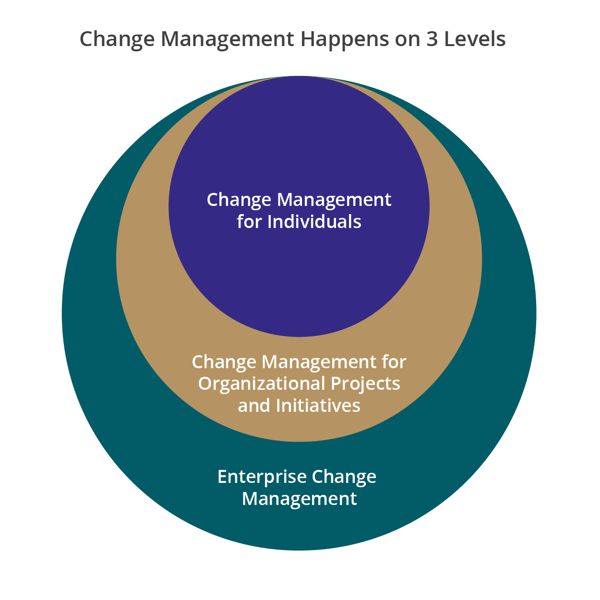You have no items in your shopping cart.
Dimensions of Change Management at the Enterprise Level

3 Mins
Updated: March 31, 2025
Published: May 25, 2022

Change management plays out on different levels within the organization. At the enterprise level, it's about building capabilities and competencies that make change management part of how the organization does business.
A Structured, Repeatable Approach
Change management provides structured, repeatable approach for organizations to ensure that projects and initiatives deliver their intended outcomes. Those intended outcomes could be streamlined processes, a better customer experience, an enhanced organizational structure, or numerous other benefits. But regardless of the project or initiative, any change that requires high levels of adoption and usage by employees also requires a focus on the people side of change.
In practice, change management takes place on three levels:
- Change management for individuals – as a framework for enabling one person to adopt and use a change, with a goal of helping them move through the change process successfully
- Change management for organizational projects and initiatives – as a benefit-realization and value-creation measure applied on particular initiatives, with a goal of mitigating risk and achieving desired outcomes
- Enterprise change management – as organizational competency and capability, with a goal of weaving change management into the fabric of the organization and becoming change-agile

Change Management at the Enterprise Level
Enterprise change management is about building organizational capabilities and competencies to more effectively bring about the tens or hundreds or thousands of changes being introduced in your organization each year. As change management practices become institutionalized and embedded, each change the organization takes on is more successful, and the change management discipline itself improves.
Dimensions of change management at the enterprise level
At the enterprise level of change management, we see three dimensions:
- Consistent application and a common set of change management processes and tools on every project
- Individual competencies at leading change, from the top of the organization to front-line employees
- A strategic capability or core competency
These characteristics do not simply occur. They must be strategically and intentionally fostered through an effort to deploy change management broadly. When these dimensions exist in an organization, change management becomes the norm. It is the expectation, not the exception. Employees, regardless of where they're located in the organization, understand and embrace their roles in bringing about successful change. And effectively adopting change becomes a differentiator and cultural value of the organization.
Common elements of enterprise change management
Enterprise change management can take many forms. How the capability manifests largely depends on the unique organization and its traits. And although there is no single acceptable approach, common elements do exist in organizations working to build organizational capabilities:
- Standard organizational approach for change management
- Supporting structure, e.g., change management office, community of practice, or center of excellence
- Training programs and curricula for change management competencies
- Common, scalable tools for change management practitioners
- Triggers for applying change management embedded in project initiation processes
- Integrated approach to project management and change management
- Appreciation of the value and importance of change management throughout the organization

3 Tips for Building Enterprise Change Capability
Leading organizations today are actively working to build a core competency and competitive advantage in change management. To start down this path, your organization must first treat "building an organizational change management capability" as a project and a change.
These tips come from decades of research and experience with organizations moving past project-level applications and toward building enterprise change capability:
1. Treat enterprise change management like a project and a change
Enterprise Level change management does not occur simply because you want it to. To create an organizational capability in change management, you must manage it as a change and as a project. This means designing, developing and deploying enterprise change management and applying change management to the project to ensure that employees embrace, adopt and use it. Prosci's Enterprise Change Management (ECM) Boot Camp is a one-day program designed to help you kickstart this work.
2. Leverage a signature win
Our work with clients and our benchmarking research clearly shows the importance of a "signature win" or "success story." An example of effective change management and its impact builds support and mobilizes energy behind a broader deployment effort. It also helps people in the organization see what it means to apply change management. If you are considering deploying enterprise change management, be deliberate in creating or capturing a success you can share with others.
3. Ensure leadership commitment
In all seven of Prosci's change management benchmarking studies, the top overall contributor to success identified has been active and visible support from executive leaders. The credibility and authority this affords cannot be understated. The same will be true of building enterprise change capability. While you can certainly make progress from the bottom up, the effort will effective sponsorship to succeed.
Start Your Enterprise Change Management Journey
Building enterprise change capability isn't just a good idea—it's becoming a competitive necessity. Organizations that embed change management into their DNA outperform those that approach change haphazardly.
The path forward is clear: treat enterprise change management as both a project and a change initiative, leverage your signature wins to build momentum, and secure unwavering leadership commitment. With these elements in place, your organization can transform from simply managing individual changes to becoming truly change-agile.


